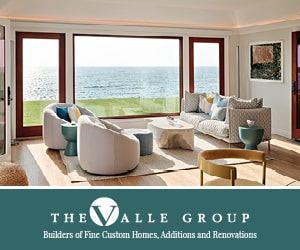
Collecting the Cape
Cape Cod Home / Winter 2020 / Home, Garden & Design
Writer: Chris White / Photographer: Peter Venderwarker
Collecting the Cape

Cape Cod Home / Winter 2020 / Home, Garden & Design
Writer: Chris White / Photographer: Peter Venderwarker
“When you’re going to renovate a house, always hire an architect you’ve known for 50 years,” say the owners of an exquisite Cape in Brewster.
Although the owners present this advice as a joke, the nature of their relationship with architect Kevin Lichten actually did directly impact the design choices for this unique project. In a sense, the renovation began over 50 years ago, when the owners and Lichten were classmates at Brown University. Lichten notes, “We share a common history; our years in Providence were important in establishing an inventory of what makes a beautiful house.”

“The East Side of the city is just gorgeous,” adds the owner. “And because of the local politics, Providence was unable to modernize in the 1960s the way many other cities did, which left much of the existing architecture in place.”
Even the reminiscence of these formative college days, in a conversation on the new screened porch of the Brewster home, reveals the type of collaboration that went into the project. While the owners have chosen careers other than architecture, the discipline remains as one of their hobbies and passions. In fact, conversations amongst the three friends about houses and design predate the renovation by decades. Their keen interest in architecture not only contributed to the successes of the project, but also factored in thematically, for this is a home with the concept of “collecting” at its core, and the owners have essentially created a living museum for themselves with various collections of art and antiques throughout the house; the actual renovations are themselves a collection of elements that Lichten and the owners accumulated together.

“We tried to harvest everything we love about Cape Cod,” says Lichten.
To accomplish this goal, the owners and architect spent many hours driving around the area looking at houses. They combed Route 6A for ideas and inspiration, taking notes on various types of traditional homes, debating which features would work best given the parameters of the existing structure and its placement on the lot. They studied chimneys, shingles and shutters, half-Capes, three-quarter-Capes, and full Capes, and they paid close attention to barns. The process developed into something far more than simple research; it came to resemble an archeological dig as they uncovered ideas and concepts that would all factor into one final, cohesive exhibit.

The owners had been living in their Brewster home for more than a decade prior to their decision to renovate; “It wasn’t really a summer house, more a second home,” explains the owner, who also lives and works in the Philadelphia area. “Our three adult children were in their late 30s and early 40s, and we have five grandchildren. We simply needed more space; the original three bedrooms were no longer enough.” One of the goals of the project was to create additional room for the extended family, but to do so in a way that would preserve the nature and appearance of the house. In other words, Lichten would need to design an addition that would serve a function without jumping out and overwhelming the character of the home. The house faces west on a quiet side road and was a 1930s full Cape: a simple, symmetrical design with a low roof and a pair of windows flanking the front door. Since the desire was to maintain this style, Lichten was limited by height as well; an addition that stood much higher than the original would draw attention away from the historical facade. The second-story ceilings in the pre-existing house are only seven feet in height, but Lichten and the owners desired more headroom, so there was no way that the new wing would line up exactly right. Lichten’s solution was to create an open porch with a slanted roof along the north side of the house, in the back. “This masks the difference in height,” he explains. “All the new bedrooms upstairs have sloped ceilings, too.” Because of this, he carefully designed windows to bring in more light and to create the feeling of additional space. “To create headroom without making a looming wall on the south side of the house, we have some crazy gable stuff going on,” Lichten notes, half-jokingly. “Getting the ceiling and windows to work was a nightmare, but features such as the quarter-round windows in one of the new bedrooms are really cool.”

In addition to the new wing on the south end of the home, Lichten and the owners attached a screened porch, stretching east into the back yard, that also serves as an entryway. As is the case with many Capes, nobody really uses the front door. “The owners wanted an outdoor room,” says Lichten. “It was important to be able to sit out there.” In their reconnaissance adventures around Route 6A, he and the owner looked at many different porches to see what would work best for them. They didn’t want something too large that would throw off the balance of the home, but it had to be big enough to meet their goals. The question was, as Lichten says, “What is ideal for a screen porch?” In this case, the size is cozy but spacious enough to include both a sitting area and a dining area, well-suited for family gatherings, though not really appropriate for a big party.
Another major component of the renovation is the barn, which actually was a follow-up project, completed a couple of years after the main house. Throughout the entire process, says Lichten, “We focused on Cape vernacular—things like the oyster shell driveway, the doors and windows, and the cedar shingle roofing.” The barn fit into this scheme, and was originally conceived of as a place for the owners to retreat to when their children and their families arrived. The owners also wanted this building to function as an actual barn—for storing boats, bikes, a car, gardening tools and the like. One of the challenges was to ensure that the barn looked natural, as though it belonged there, as though it had always been there. Lichten explains, “We didn’t want it to look ‘designed.’ Getting it to work and not feel self-conscious was tough.” As with the renovation of the house, the barn project involved a combination of research in architecture books and a lot of time driving up and down Route 6A, where once again the owners and architect collected ideas that would inform their plans. While fitting in with the Cape style, Lichten notes, “It’s also a reference to the mill buildings in New Bedford and Fall River.” The living space is upstairs in the barn, but the owners decided that they would use it as a guest apartment rather than move out there. It features elemental materials such as teak cabinetry and copper counters, faucets and sinks. The owner recalls, “We picked up the idea for the copper counter from Fin, the restaurant in Dennis.”

Just as the exterior appearances of the home, barn and the grounds are the result of ideas gathered to create a holistic experience, the interior spaces continue the theme of collecting. In fact, the home feels like a well-curated gallery. The owners love art and thoughtfully display paintings in every room, including many pieces by local artists. They are also antiques collectors, so tables, dressers and other furniture items predate the original home. Their collections of clocks, barometers, rugs and china are extensive and complement both the design of the house and its theme. And, it is the exquisite attention to detail that really sets the entire project apart from a typical renovation. Craig Ashworth of E.B. Norris & Sons, Inc. and Scott Sisson of Homes By Sisson, Inc. led the construction teams for the house and barn, respectively, and paid attention to particulars such as the color of the mortar in the new chimneys and the use of unlacquered brass for doorknobs and other fixtures—“so it would tarnish nicely,” says Lichten. The window surrounds, built-ins and wide-plank wainscoting are just a few examples of ways that the new wing of the house remains authentic to the design of the original. “We tried to capture and preserve real 1930’s features such as the low storage cabinets in the older bedrooms,” says Lichten, who also delights in the number of “eccentricities” that they were able to weave in. The owners discovered and procured new mantles for the fireplaces in their travels, as well. “We found the dining room mantle in Connecticut,” recalls the owner, “put it in a U-Haul, and brought it up with us.” The new dining room is nearly square, which makes it difficult to furnish, but the owners discovered a square table from the early 18th century that fits perfectly and is ideal for four to eight guests. Lichten used Harmon-hinge doors, which his firm “uses all the time” as the segue from this more public space to the private part of the wing, which contains the master bedroom suite.

The transitional area between the dining room and the master bedroom is one of the most distinctive parts of the house, its main stairway. Lichten says, “The house really expands here. It’s a pastiche, an homage to the early settlers on the Cape.” Constructed of pine, the staircase is large and bold, in contrast to many of the home’s other, more subtle features. “It’s Jacobean style,” notes Lichten, “something you would find in a 16th-century English house.” One can almost feel the weight of this feature, and it seems to anchor the home both literally and in history. In fact, from the interior, one could be forgiven for believing that the new wing is actually the older section of the house, and yet the aforementioned increased ceiling height, modern amenities and other contemporary living elements belie the truth.

“Often in renovations, the charm is obliterated,” says the owner, “but Kevin’s creativity allowed us to preserve it. It was a great collaboration with him and the builders.”
Lichten adds, “We agreed on all the things that were wrong. I’ve never had problems working for friends, but this was one of the most enjoyable projects I’ve ever worked on. Many clients see the design process as more of a painful necessity…”
“My favorite part was the process!” interjects the owner. “And there’s not much more that we could do here; now it’s just a matter of maintenance. It really was fun, as all projects should be. Having known each other for so long and so well, it was just great to work together.”
Make sure to visit Kevin Litchen online here!
And check out other stories from our Winter 2020 issue here!



